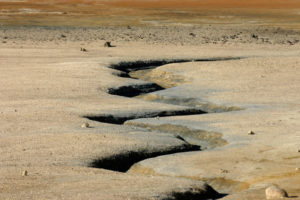A River’s Right to Flow
March 28, 2018
 Do rivers have a right to water?
Do rivers have a right to water?
As dams and diversions deplete flows, it’s a question environmental advocates and legal scholars are asking more and more. Over the last decade, rivers in Ecuador and New Zealand have won legal rights, and a recent case in the western United States attempted to do the same for the Colorado River.
While it is tempting to brush these legal moves off as aberrations, a wiser course of action is to proactively step up efforts to restore rivers to better health.
The case filed in federal district court in Denver last September to establish a legal right for the Colorado River ecosystem to “exist” and “flourish” and to have the benefit, as people and corporations do, of representation in a court of law, was akin to a cry from the mountaintops to rescue this culturally prized, ecologically magnificent, but highly damaged river system.
Some viewed the case as nonsensical, and, while it drew substantial media attention, it appeared fraught from the start. In early December, under pressure from the state of Colorado’s attorney general, the plaintiffs withdrew their case.
But the hard truth remains that existing laws and policies have failed to protect the health and integrity of the Colorado River and its tributaries, which supply water to some 40 million people and 5 million acres of farmland. The river no longer reaches the sea, many miles of tributaries routinely run dry, and fish, birds and wildlife have lost vital habitat.
Fundamentally, this case and others like it ask a profound ethical question: Are rivers and other aspects of nature only commodities for humans to own and exploit, or does nature have intrinsic values and rights of its own that demand human recognition and protection?
Over the last decade, the “rights of nature” movement has clearly gained steam. In September 2008, the South American nation of Ecuador became the first country to recognize such rights in its constitution. In a 2011 case brought to protect the Vilcabamba River from a public road-widening project, an Ecuadorian provincial court ruled in favor of the river.
In 2012, in one of New Zealand’s longest-running court cases, the indigenous Māori people won legal status for the Whanganui River, the nation’s third largest. Two guardians, one appointed by the Māori and the other by the Crown, will protect the river’s interests. And in early 2017, a lower court in India granted legal status to the venerated but highly polluted Ganges River, a ruling later suspended by India’s Supreme Court but that is likely to be further challenged.
In the US context the whole idea of a legal voice for rivers might seem outlandish, but it is not. In a dissenting opinion in the 1972 Supreme Court case of Sierra Club v Morton, Justice William O. Douglas argued for the conferral of standing upon natural entities so that legitimate legal claims could be made for their preservation. The river, Douglas wrote, “is the living symbol of all the life it sustains or nourishes—fish, aquatic insects, water ouzels, otter, fisher, deer, elk, bear, and all other animals, including man, who are dependent on it or who enjoy it for its sight, its sound, or its life. The river as plaintiff speaks for the ecological unit of life that is part of it.”
In its fullest expression, granting legal rights for the Colorado River could upend the existing system of private water rights in the effort to accommodate the ecosystem’s water needs. While that is unlikely to happen any time soon, the prospect of another such case – and more importantly the growing attention to the ethical issues it raises – is a wake-up call for state and federal agencies and stakeholders throughout the watershed to make better use of existing tools to protect the health of rivers.
Conservation, efficiency improvements, groundwater replenishment and markets are proven, cost-effective tools that are under-utilized. Especially in agriculture, incentives to invest in efficiency – from micro-irrigation to soil sensors to canal modernization – could free up water to restore depleted rivers.
Such sensible measures could also help avoid the need for costly new supply projects: today, proposed dams and diversions in the upper Colorado River Basin would collectively drain an additional 300,000 acre-feet (nearly 100 billion gallons) a year from already stressed rivers, streams and reservoirs.
The drought that has plagued the Colorado Basin since 2000 is a prelude of things to come. Climate researchers estimate that rising temperatures alone could reduce water flows in the Colorado Basin by 20 percent or more below the 20th century average. To satisfy the river’s water users and ecosystem needs will require adjustments in water policy, management and use.
If, as Martin Luther King said, the arc of the moral universe is long, but bends toward justice, the extension of rights to nature may eventually take hold and spread.
Meanwhile, much can be done to protect rivers while respecting the rights and interests of existing users and communities.
Originally posted at National Geographic.
